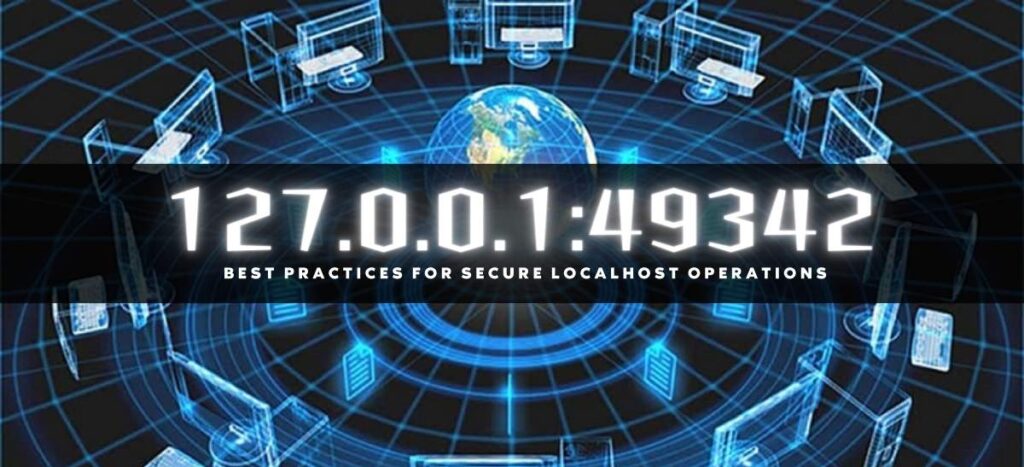Introduction to 127.0.0.1:49342
Welcome to the ultimate guide on unravelling the mysteries of 127.0.0.1:49342 – a digital realm where troubleshooting meets innovation! Have you ever wondered about the significance of this enigmatic combination of numbers? Join us on a journey through localhost’s evolution, understanding, and configuration like never before. Let’s dive into the depths of web development and uncover the secrets behind 127.0.0.1:49342!
The History and Evolution of Localhost

Have you ever wondered about the origins of “localhost” and how it has become a fundamental part of web development? The concept of localhost traces back to the early days of computer networking when engineers needed a way to refer to their machines.
Initially, localhost was associated with the loopback network interface on a device, allowing programs to communicate with themselves. As technology advanced, developers began using the IP address 127.0.0.1 as a standard representation for localhost.
Over time, “localhost” evolved into a universal identifier for referring to one’s computer in software development environments. Today, it plays a crucial role in testing and troubleshooting applications locally before deployment.
Understanding this history sheds light on why localhost continues to be an essential tool for developers worldwide, enabling them to fine-tune their projects with ease and efficiency.
Understanding the IP Address and Port Number in 127.0.0.1:49342

Have you ever wondered about the mysterious combination of numbers that make up an IP address and port number like 127.0.0.1:49342? Let’s dive into the world of networking to unravel this digital code.
The IP address 127.0.0.1 is known as localhost, a unique value that refers to your computer. It’s like talking to yourself in vast cyberspace, a loopback connection where data sent is received internally without going out to the network.
On the other hand, port 49342 acts as a door within your computer where different programs can send and receive data. Each application running on your system listens on its assigned port for incoming information or requests.
When combined, 127.0.0…
Common Uses of 127.0.0.1:49342 in Web Development and Troubleshooting

Regarding web development and troubleshooting, 127.0.0.1:49342 plays a crucial role in testing applications locally before deploying them on servers. Developers often use this local IP address and port number combination to run and debug their code without affecting live websites.
By configuring the software to listen on 127.0.0.1:49342, developers can simulate server environments on their machines for efficient debugging processes. This enables them to quickly catch and fix bugs before pushing updates live.
Additionally, 127.0.0.1:49342 is commonly utilized for setting up local databases or running scripts that require network connections within the development environment without external access.
Understanding the various uses of 127..0..01:49342 allows developers to streamline their workflow and ensure smoother deployments of web applications with minimal disruptions or errors during production releases.
Configuring 127.0.0.1:49342 for Different Operating Systems (Windows, Mac, Linux)
Configuring 127.0.0.1:49342 for different operating systems is crucial for seamless web development and troubleshooting tasks. In Windows, you can configure it by editing the host file located in the C: WindowsSystem32driversetc directory. Add “127.0.0.1 localhost:49342” at the end of the file.
For Mac users, open Terminal and edit the host file using a text editor like nano or vi to include “127.0.0.1 localhost:49342”. Save the changes and flush the DNS cache using ‘sudo killall -HUP mDNSResponder’.
Linux users can configure it similarly by editing the /etc/hosts file with sudo privileges to append “127.0.0..1 localhost:49342”. Remember to save your changes and restart networking services.
Each operating system has its unique steps, but 127…00 will significantly enhance your local development environment without much hassle once configured correctly!
Tips and
Are you looking to make the most out of 127.0.0.1:49342? Here are some handy tips to enhance your experience:
1. **Stay Updated**: Keep abreast of the latest developments in web development tools and technologies to maximize the use of 127.0.0.1:49342.
2. **Backup Regularly**: Always back up your essential files and configurations before making any changes to ensure smooth operations.
3. **Utilize Resources**: Leverage online tutorials, forums, and communities for troubleshooting tips and best practices when configuring 127.0.0.1:49342.
4**Test Thoroughly**: Before deploying any changes or updates, thoroughly test them on localhost using 127**00**01:**49342** to catch any potential issues early on.
5**Experiment Freely**: Don’t be afraid to experiment with different settings and configurations on localhost; it’s a safe environment for testing new ideas without impacting live websites.
FAQs
Q: What does 127.0.0.1:49342 mean in web development?
A: In web development, 127.0.0.1:49342 refers to the local IP address and port number where developers can test and troubleshoot their applications before deploying them live.
Q: Can I change the port number of 127.0.0.1 on my computer?
A: Yes, you can modify the settings in your web server configuration files to configure a different port number for localhost on your computer.
Q: Is it safe to use 127.0.0.1 for testing websites?
A: Yes, using 127.0.0..1 for testing websites is safe as it isolates the testing environment from the internet, ensuring that only you can access the site during development.
Also Read: Matka Cartoon



